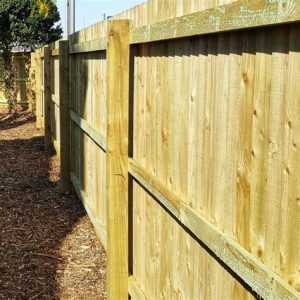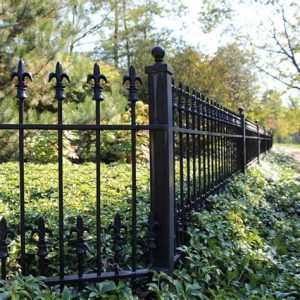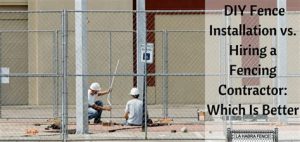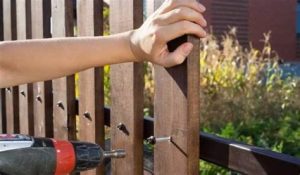Learn essential steps for fence installation, from checking zoning regulations to preparing layout, ensuring a successful project that meets all requirements.When it comes to enhancing your property’s privacy and aesthetics, installing a fence is an excellent option. However, before diving into the installation process, it’s essential to prepare your yard meticulously to ensure everything goes smoothly. From understanding local zoning regulations to accurately measuring your property boundaries, each step plays a crucial role in the success of your fencing project. Additionally, clearing away any vegetation and debris, checking for underground utility lines, and thoughtfully planning the layout are all vital tasks that can prevent potential complications down the road. In this blog post, we’ll provide you with a comprehensive checklist to guide you through each preparatory phase, ensuring your fence installation is efficient and hassle-free. Let’s get started!
Checking local zoning regulations
Before you begin the exciting process of installing a fence, it’s crucial to check the local zoning regulations in your area. Zoning laws can significantly affect your project by dictating where and how you can construct your fence. Understanding these regulations will not only help you stay compliant but also save you from potential fines or required removal of your fence later on.
- Height restrictions: Many areas have limits on how tall your fence can be. This is especially important for the front yard, where the regulations might be stricter.
- Property lines: Make sure to confirm your property boundaries. Building too close to the line could lead to disputes with neighbors or require you to dismantle your fence.
- Material regulations: Some municipalities may have specific regulations on the types of materials you can use, especially if you’re in a historic district.
Visit your local zoning office or their website for detailed information on the zoning regulations that apply to your property. This step is essential, as it ensures you will proceed with your fence installation without any legal concerns.
Measuring the property boundaries accurately
One of the essential steps in preparing your yard for fence installation is measuring the property boundaries accurately. Knowing where your property lines are will not only help you stay within the legal limits but also ensure that your fence is properly positioned for maximum effectiveness.
- Obtain a Survey Map: Start by acquiring a survey map from your local land records office. This map will outline the official boundaries of your property.
- Use Reliable Measuring Tools: Invest in a good quality measuring tape or surveyor’s wheel. For larger properties, consider using a laser distance measurer.
- Mark the Corners: Use stakes or flags to mark the corners of your property. This will provide a visual guide and help you avoid any confusion during installation.
It’s important to note that the boundaries may be affected by any easements or rights-of-way. To prevent any disputes with neighbors, it is wise to have your property surveyed by a professional if you are uncertain about the lines. Ensuring that you measure the property boundaries accurately saves not only time but also potential legal issues down the road.
Clearing vegetation and debris
Before embarking on your fence installation project, one critical step is clearing vegetation and debris from the area where the fence will be placed. This phase not only prepares your yard for installation but also ensures that the boundary lines are clear and visible.
Begin by walking through the designated area and identifying any plants, shrubs, or trees that may obstruct the fence installation.
- Survey the Area: Assess the entire perimeter where the fence will go to identify all types of vegetation.
- Remove Obstacles: Clear away any large rocks, branches, or debris that could impede the installation process.
- Trim or Remove Vegetation: Depending on your preferences, trim back foliage or remove plants that are too close to the installation site.
Additionally, be aware of any local wildlife or plants of interest that may need special handling to preserve local ecosystems. If in doubt, consult with a landscaping professional who can advise you on best practices for clearing without causing harm.
By effectively managing vegetation and debris, you create a smoother installation process for your new fence while ensuring its longevity and stability. Remember, this step is essential for preventing complications later on.
Contacting utility companies for underground lines
Before you start your fence installation, it’s crucial to ensure safety and compliance by contacting your local utility companies. These companies can provide you with information regarding any underground lines in your yard that may pose a risk during the installation process.
To begin, reach out to utility providers such as your local water, gas, electric, and telecommunications companies. They usually have a process in place for marking the location of their underground infrastructure. This step is vital as it helps avoid accidental damage, which could lead to service disruptions or even safety hazards.
In many regions, you can also contact a one-call service or a 811 hotline that coordinates with various utility companies to mark underground lines in your area. Once you initiate the request, a representative will typically visit your property to mark the locations of any buried utilities using paint or flags. This ensures you have a clear view of where to avoid digging when preparing for your fence installation.
Preparing the layout for the fence installation
When it comes to fence installation, laying out your design is a crucial step that sets the foundation for a successful project. A well-prepared layout ensures that your fence is not only functional but also aesthetically pleasing and compliant with local regulations. Here’s a comprehensive checklist to guide you through the preparation of your layout for the fence installation.
1. Determine Fence Location: Before you start, it’s essential to map out where your fence will go. Use stakes and string to outline the projected path. This gives you a visual representation of how the fence will fit into the yard.
2. Measure Distances: Accurate measurements are vital. Use a measuring tape to get the distances between the stakes, ensuring that you account for any gates or openings you want to include. It’s advisable to double-check your measurements to avoid costly mistakes.
3. Consider Local Regulations: Make sure to check local zoning regulations regarding fencing. Some areas have restrictions on height, materials, and placement. This will prevent potential legal issues down the road and ensure your fence adheres to community standards.
| Task | Status |
|---|---|
| Map out fence path | ✔️ Complete |
| Measure distances accurately | ✔️ In progress |
| Check zoning regulations | ✔️ Not started |
By taking these careful steps to prepare your layout, you’ll pave the way for a smooth fence installation process. Remember, a little planning now can save time and ensure compliance later.
Frequently Asked Questions
What is the first step in preparing my yard for fence installation?
The first step is to assess your property lines to ensure the fence is built within your boundaries and avoids encroachment on neighboring properties.
Do I need to obtain a permit for fence installation?
Yes, many local jurisdictions require a permit for fence installation. Check with your local government office to find out the specific requirements in your area.
How should I clear the area where the fence will be installed?
You should remove any obstacles such as plants, rocks, debris, and old fencing within the planned area to ensure smooth installation.
What tools do I need for fence installation preparation?
Common tools required include a tape measure, stakes, string, a post hole digger, and a level to accurately mark and prepare the installation site.
How do I mark the fence line for installation?
You can mark the fence line by using stakes and string to visualize the boundary. This will help ensure a straight alignment while installing the fence.
Should I consult a professional for fence installation?
While some homeowners prefer DIY installation, consulting a professional can help ensure that the fence is installed correctly and adheres to local codes.
What are common mistakes to avoid when preparing for fence installation?
Common mistakes include not checking property lines, failing to obtain necessary permits, and neglecting to mark underground utilities, which can lead to costly damages.




